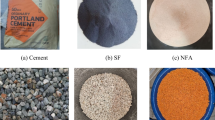Abstract
Several devices are used to provide support in an underground space. Wooden prop is generally employed for the purpose of passive secondary or short-term support of the mine roadway roof and sides. The wooden prop has various known usage limitation, including low strength, deterioration of wood in humid environment, poor ductility, and generally low service life. Substitution of the wooden prop with a prop made with a more suitable material could thus yield important advantages. In this study, lightweight aggregate concrete (LWAC) is proposed to be used as a prop material. Since lightweight aggregate has a relatively low ductility, steel fibers are used in this investigation to achieve enhanced ductility levels. Five mixtures of fiber reinforced lightweight aggregate concrete were considered with different steel fiber percentages and pumice lightweight aggregates produced in Iran. The density, compressive, tensile and flexural strength as well as the toughness index of different fiber reinforced lightweight aggregate concrete materials were measured in order to assess their potential as replacement for wood in prop production. The experimental results indicated that the density of lightweight aggregate concrete is higher than wood. Since the strength and toughness of LWAC is significantly more than those of wood, the weight of a LWAC element with the same strength turns out to be 22 percent less than the wood element. Hence, wooden prop may be replaced with lightweight aggregate concrete prop to achieve improved service life and ductility while reducing the weight of the prop.
Similar content being viewed by others
References
Skinner, E.H., Structural Uses and Placement Techniques for Lightweight Concrete in Underground Mining, Report of Investigation 9266, Bureau of Mine, United States Department of Intereior, 1989.
McWilliams, P.C. and Gooch, A.E., Ground Support Systems in Block-Cave Mining, A Survey, BuMines IC 8679, 1975.
Bigby, D., Coal Mine Roadway Support System Handbook, Crown, UK, ISBN 0 7176 2899 X, 2004.
Liu, H.Y., Small, J.C., and Carter, J.P., “Full 3D Modelling for Effects of Tunnelling on Existing Support Systems in the Sydney Region,” Tunnelling and Underground Space Technology, 2008, vol. 23.
General Description and Arrangement of Face Supports, Durham Mining Musium ebook, Chapter 1, Crown, License Number C01W0000177, 2004.
Song, H.W. and Lu, S.M., “Repair of a Deep-Mine Permanent Access Tunnel Using Bolt, Mesh and Shotcrete,” Tunnelling and Underground Space Technology, 2011, vol. 16.
Robert, M.K.C., “An Evaluation of Yeilding Timber Props as a Suport System in Rockburst Conditions,” Journal of the South African Instittue of Mining and Mettalurgy, 1991, vol. 91, no. 7.
Erusmus, P.E. and Smit, J., “Assessment of Pre-Cast Foamed Concrete as Support Medium in Deep Level Mining,” Proc. Int. Conf. Roamed Concrete in Construction, University of Dundee, Scotland, UK, 2005.
Demirboga, R., Rung, I.O., and Gul, R., “Effects of Expanded Perlite Aggregate and Mineral Admixtures on the Compressive Strength of Low-Density Concretes,” Cement and Concrete Research, 2001, vol. 21.
Newman, J.B. and Bremner, T.W., The Testing of Structural Lightweight Concrete, The Concrete Society, The Construction Press, Lancaster, UK, 1980.
Gqndqz, L. and Uğur, I., “The Effects of Different Fine and Coarse Pumice Aggregate/Cement Ratios on the Structural Concrete Properties without Using Any Admixtures, Cement and Concrete Research, 2005, vol. 35.
Shekarchi, M., Mahoutian, M., Libre, N., and Yekta, S., Comparison between the Effect of Pumice and Leca on the Mechanical Properties of Fiber Reinforced Lightweight Aggregate Concrete,” Proc. 3rd Conf. Civil Engineering, Tabriz, Iran, 2007 (in Persian).
Chen, B. and Liu, J., “Contribution of Hybrid Fibers on the Properties of the High-Strength Lightweight Concrete Having Good Workability,” Cement and Concrete Research, 2005, vol. 35.
Campione, G. and Mendola L., “Behavior in Compression of Lightweight Fiber Reinforced Concrete Confined with Transverse Steel Reinforcement,” Cement and Concrete Research, 2004, vol. 26.
Nasseri, A., Lightweight Aggregate in Iran, Construction Materials Institute Publication, Report 07A86, Iran, 2007.
Khandaker, M. and Anwar, M., “Bond Characteristics of Plain and Deformed Bars in Lightweight Pumice Concrete,” Construction and Building Materials, 2008, vol. 22.
Gündüz, L., “The Effects of Pumice Aggregate/Cement Ratios on the Low-Strength Concrete Properties, Construction and Building Materials,” 2008, vol. 22.
Khandaker, M. and Anwar, M., “Pumice Based Blended Cement Concretes Exposed to Marine Environment: Effects of Mix Composition and Curing Conditions,” Cement and Concrete Composites, 2008, vol. 30
Topcu, I. and Uygunoglu, T., “Properties of Autoclaved Lightweight Aggregate Concrete,” Building and Environment, 2007, vol. 42.
Cavaleri, L., Miraglia, N., and Papia, M., “Pumice Concrete for Structural Wall Panels,” Engineering Structures, 2003, vol. 25.
Habel, K., Viviani, M., Denarie, E., and Bruhwiler, E., “Development of the Mechnaical Properties of an Ultra High Performance Fiber Reinforced Concrete,” Cement and Concrete Research, 2007, vol. 36, no. 7.
Namman, A.E., Otter, D., and Najm, H., “Elastic Modulus of SIFCON in Tension and Compression,” ACI Materilas Journal, 1991, vol. 88, no. 6.
Montesions, P. and Gustavo, J., “High Performance Fiber Reinforced Cement Composites: An Alternative for Seismic Design of Structures,” ACI Structural Journal, 2005, vol. 102, no. 5.
Timber Manual, Datafile P1, Timber, Species and Properties, Forest and Wood Products Research & Development Corporation, Australia, ISBN 1 86346 006 3, 2004.
Binici, H., Aksogan, O., Gorur, E.B., Kaplan, H., and Bodur, M.N., “Performance of Ground Blast Furnace Slag and Ground Basaltic Pumice Concrete against Seawater Attack,” Construction and Building Materials, 2008, vol. 22, no. 7.
Hossain, K.M.A. and Lachemi, M., “Mixture Design, Strength, Durability, and Fire Resistance of Lightweight Pumice Concrete,” ACI Materials Journal, 2007, vol. 104, no. 5.
Hossain, K.M.A., “Macro- and Microstructural Investigations on Strength and Durability of Pumice Concrete at High Temperature,” Journal of Materials in Civil Engineering, 2007, vol. 18, no. 4.
Author information
Authors and Affiliations
Corresponding author
Additional information
The article is published in the original.
Original English Text © M. Mahoutian, M. Shekarchi, N. Ali Libre, 2009.
Rights and permissions
About this article
Cite this article
Mahoutian, M., Shekarchi, M. & Libre, N.A. Application of steel fiber reinforced lightweight aggregate concrete in underground mining. J Min Sci 47, 606–617 (2011). https://doi.org/10.1134/S1062739147050091
Received:
Published:
Issue Date:
DOI: https://doi.org/10.1134/S1062739147050091




